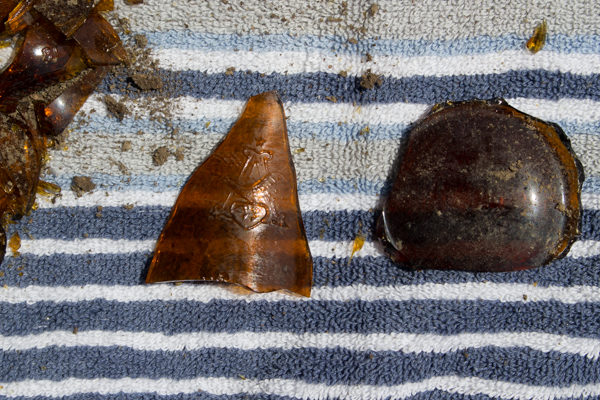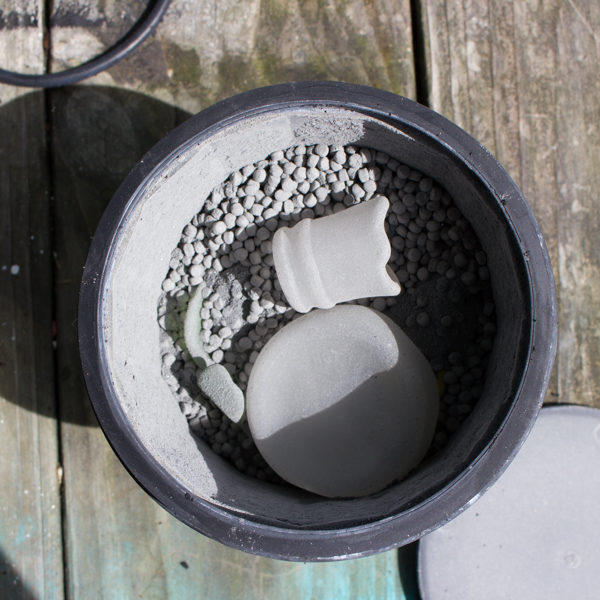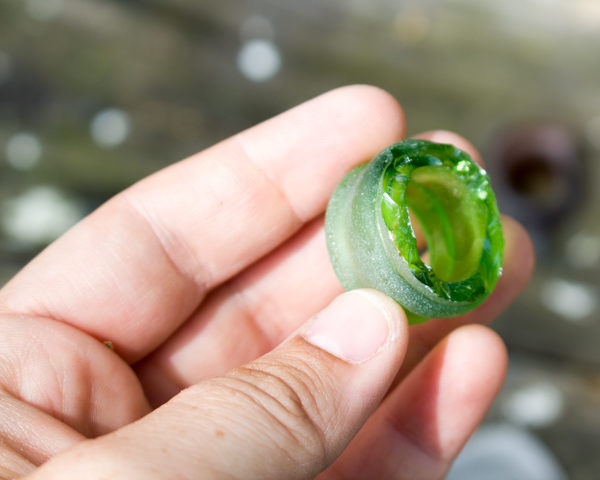Many of you responded to this declaration with something along the lines of “OMG PLZ TELL ME IF IT WORKS OMG GASP OPEN-MOUNTED EMOJI OMG!!!1!!!!” Based on these comments, I’m feeling like you want me to tell you how my experiment went. Result: It. Was. AWESOME!!! Yes, you can 100% make sea glass in a rock tumbler. It’s super easy, and it comes out straight-up looking like sea glass. Here’s how to do it.
Tools & Materials
You will need the following tools and materials:
Steps to Make Sea Glass in a Rock Tumbler
1. Break some (thicker) glass
As I mentioned before, I’m using vintage glass bottles to make sea glass, because that’s what I have a million of and need to find more things to do with. I’m primarily choosing either the glass bottles that were broken when I found them, or that are of unimportant provenance. I clean up and polish the nice vintage glass bottles and display them around my house, even though I’ve frankly got too many of those, as well. The guide mentioned below recommends avoiding thinner glass – it can work, but will not turn out as nice as the heavier old style bottles and thicker jars. ANYWAY… my preferred method of breaking a glass bottle is to wrap it in a towel, set it on my driveway, then whack it with a hammer. From the mess of broken glass, I pick out the nice pieces that I want to tumble. I really like bottle necks and bottle bottoms (ahem…), and also the side pieces if they’ve broken into a shape that I think will look nice when tumbled. Use the tile nippers to trim a piece of broken glass into a more interesting shape, or chip off the edges around a bottle’s bottom.
2. Set up the rock tumbler
You’ll need to read the instructions on how to user your tumbler. For ours, the hardest step is learning how to open and seal the tumbler itself so it doesn’t leak. RockTumbler.com has some good instructions on using your tumbler for sea glass. Note, however, that the instructions explicitly tell you not to use glass bottles. My experience is that you can, although you still want to avoid any glass that’s too thin. A Coca-Cola bottle should work. A spaghetti sauce jar probably won’t.
3. Check your work over 1-7 days
You can tumble glass for as little as 24 hours and see results – typically a light scuff on the surface but the sharp edges can be removed. But for the full sea glass effect, you’ll want to wait a little longer. When you open up your rock tumbler after five or so days, the inside will look like this: Instead of sifting out the tumbled glass, I pick it out of the matrix and examine it. A couple of times, a piece has cracked and needs to be set aside. Sometimes, a piece is perfect just the way that it is and I love it. Most times, though, the tumbled piece is almost perfect, but still needs some refining. For that, get the tile nippers back out. For instance, after examining that bottle neck in the above photograph, I decided that I’d like it better if it was trimmed even closer to the edge, so I did:
4. Go for round #2
Pop any glass that you’ve trimmed, and enough new pieces to maintain the level in your tumbler, back into the barrel with the same grit and filler material. Give it a go for another five or so days, and then take a look. Repeat until you’re happy! You can use your DIY sea glass for any projects that call for the real deal.
Tips
Use sand instead of grit! If you want to make this process cheaper, we tried it with regular beach sand instead of course grit and the process worked just fine. Sand is, after all, what causes naturally occurring sea glass. Keep a tupperware of broken glass until you’re ready to make a batch I keep a small bin labeled broken glass, and I keep a towel in there that I use when I’m breaking up the glass pieces. When someone in our house drops a glass object, we clean up the little shards but I put the big pieces in this bin. I also keep the same towel in the bin so that I don’t accidentally leave glass shards in the towel and use it elsewhere in our house. Authored by Julie Finn. Updates by Kane Jamison.






